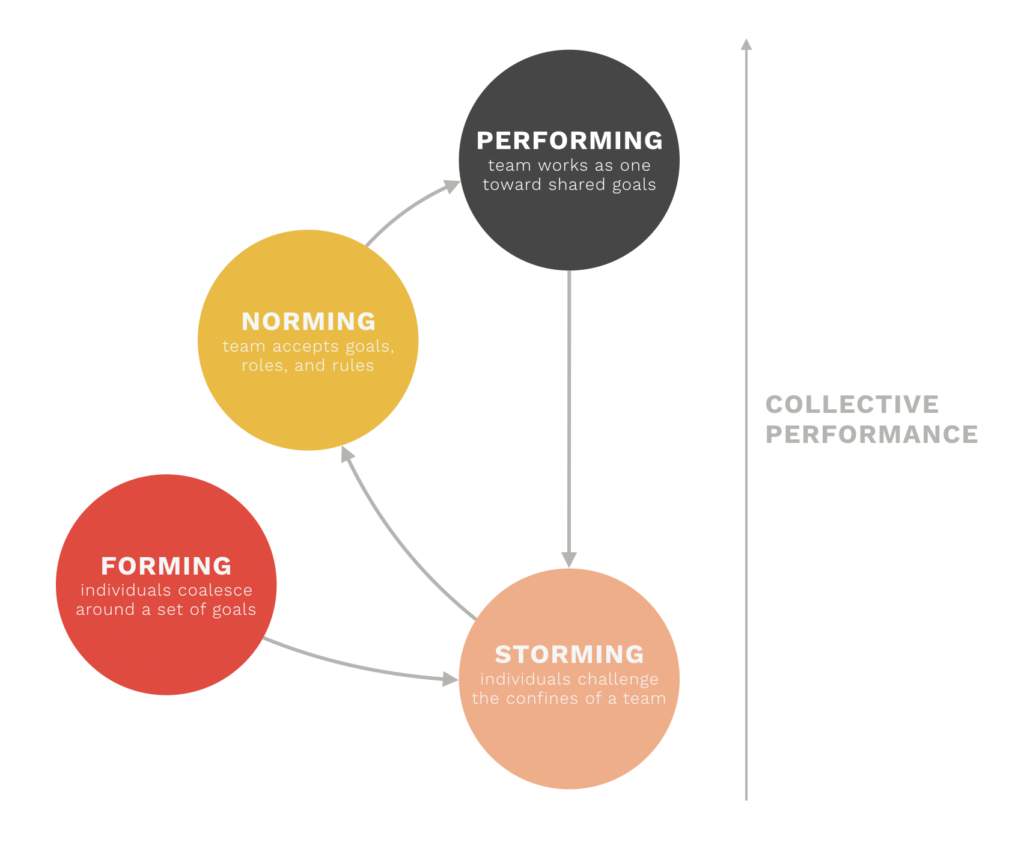Teams these days face a rather unusual situation: new hires are expected to develop working relationships with people they’ve never met in person. Onboarding, celebrations, and collaboration are tricky enough done virtually, though it’s possible to compensate. What’s really challenging are those tense, but critical, moments in a team’s existence, like disagreement, tough feedback, or difficult conversations around structural issues.
According to psychologist Bruce Tuckman, this is “storming”—one of the four stages teams go through on their way to becoming high-performing teams. It’s when teams uncover tensions and working styles start to clash. While some fall apart at this stage, if you successfully navigate it, it builds real trust and defines how the team will work together.

Let’s be clear, storming isn’t exactly easy in person. But it is easy to misread tone from Slack or email messages, and hard to read body language and nuance on Zoom (especially because facial expressions are more ambiguous than you think). That’s if you’re watching the other person at all—we’re easily distracted by watching ourselves on Zoom. And it’s not just your conscious reading of body language and non-verbal communication; it’s energetic—you literally get “in sync” with someone when you’re in person with them.
If you’re struggling through virtual “storming,” try the following:
- Build user manuals. Be explicit about how you like to work and communicate, like saying “I’m a manager who appreciates when…” This compensates for the knowledge people would normally gain about you through body language and more casual conversation outside of meetings. We’ve been using our “check-in” rounds to ask user-manual related questions, like “How do you prefer to receive feedback?”, “How are you often misunderstood”, or “What does it look like when you disagree?” This turns the behavior into a regular rituals, rather than a one-time time practice that no one revisits.
- Facilitate debates. When you reach an issue that could get heated, keep it structured and ask someone to play the role of facilitator. This means they will need to not be involved in the debate itself, so you may have to bring in someone who is adjacent to the challenge, rather than in the thick of it. Set an agenda in advance so everyone has time to prepare, keep the discussion focused, and set a time limit so people can’t get off track. It may be helpful to develop a pre-read with details on the topic being discussed, so that everyone comes in with enough operational understanding (we call this “operational empathy”) to provide useful perspectives.
- Propose solutions. When debating a tricky topic, even leadership teams have a tendency to ask, “What should we do about X?” It might feel like asking an open-ended question is a more constructive way to collaborate, but the real goal is to create an environment where healthy dissent leads to progress. So instead, suggest an option—“We should do X”—and debate its merits.
- Disagree and commit. In the “forming” stage, when everyone’s trying to get along, you’ll spend time working towards a compromise that everyone’s happy with. But to move faster, you may need to accept a solution that you dislike, as long as it doesn’t fundamentally hurt the business. Jeff Bezos refers to this as “disagree and commit.” Amazon leaders are expected to challenge ideas, but once a decision is reached, they’re responsible for doing everything they can to make it succeed.
- Be self-aware. If you’re the leader, be especially cognizant of the norms you’re establishing. Do you need to step back, or be more directive? How do you respond when someone shares bad news or an idea you don’t like? People will take their cues from you. Being aware of your style is always a challenge, so solicit feedback from those whom you know will tell you the truth.
- Hold a retro. The fastest way to speed up the storming phase and get to “norming” is by setting aside explicit time for the team to reflect on how they work together and decide on ways they’ll adapt and evolve.
Finally, let’s talk about the elephant in the room: forced office fun in the time of COVID. We enjoy our colleagues as much as the next team, but many of us prefer to have the freedom to select when and how we spend time with coworkers outside of work. So instead of setting up weekly happy hours, for example, offer to pay for experiences if they involve two or more departments and less than 10 people. This allows people to opt in and design their own version of bonding, and strikes a balance between all-company fun and small groups.








The Evolutionary Edge
Every Link Ever from Our Newsletter
Why Self-Organizing is So Hard
Welcome to the Era of the Empowered Employee
The Power of “What If?” and “Why Not?”
An Adaptive Approach to the Strategic Planning Process
Why Culture/Market Fit Is More Important than Product/Market Fit
Group Decision Making Model: How to Make Better Decisions as a Team